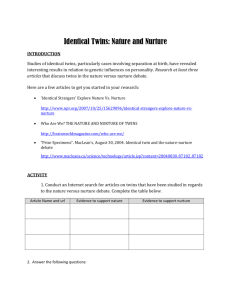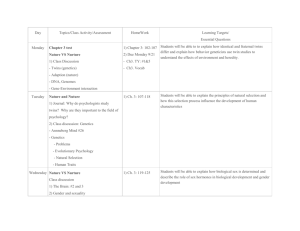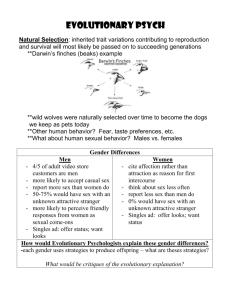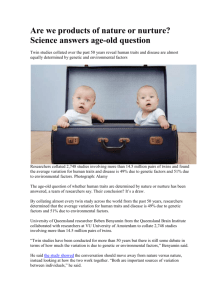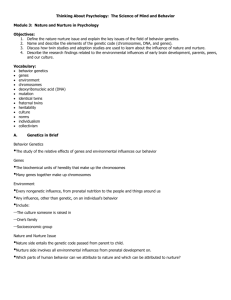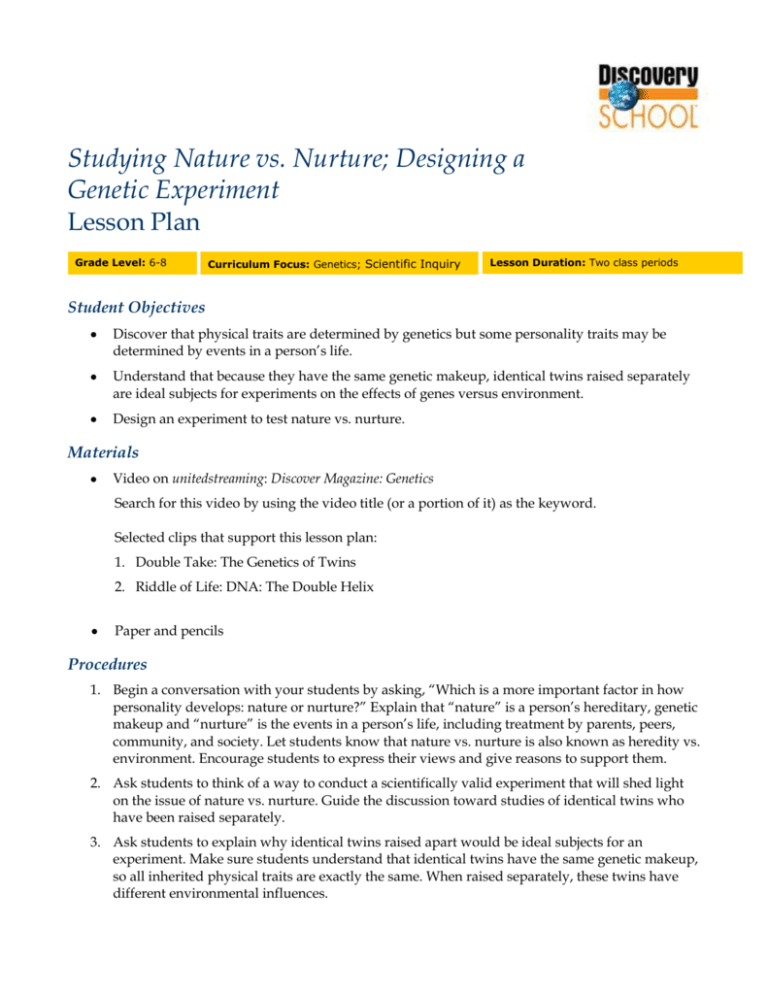
Studying Nature vs. Nurture; Designing a
Genetic Experiment
Lesson Plan
Grade Level: 6-8
Curriculum Focus: Genetics; Scientific Inquiry
Lesson Duration: Two class periods
Student Objectives
Discover that physical traits are determined by genetics but some personality traits may be
determined by events in a person’s life.
Understand that because they have the same genetic makeup, identical twins raised separately
are ideal subjects for experiments on the effects of genes versus environment.
Design an experiment to test nature vs. nurture.
Materials
Video on unitedstreaming: Discover Magazine: Genetics
Search for this video by using the video title (or a portion of it) as the keyword.
Selected clips that support this lesson plan:
1. Double Take: The Genetics of Twins
2. Riddle of Life: DNA: The Double Helix
Paper and pencils
Procedures
1. Begin a conversation with your students by asking, “Which is a more important factor in how
personality develops: nature or nurture?” Explain that “nature” is a person’s hereditary, genetic
makeup and “nurture” is the events in a person’s life, including treatment by parents, peers,
community, and society. Let students know that nature vs. nurture is also known as heredity vs.
environment. Encourage students to express their views and give reasons to support them.
2. Ask students to think of a way to conduct a scientifically valid experiment that will shed light
on the issue of nature vs. nurture. Guide the discussion toward studies of identical twins who
have been raised separately.
3. Ask students to explain why identical twins raised apart would be ideal subjects for an
experiment. Make sure students understand that identical twins have the same genetic makeup,
so all inherited physical traits are exactly the same. When raised separately, these twins have
different environmental influences.
Studying Nature vs. Nurture; Designing a Genetic Experiment
Lesson Plan
2
4. Divide the class into groups, and have each group brainstorm an experiment designed to cast
light on nature vs. nurture. Students’ experiments should involve a set of identical twins raised
separately.
5. Before groups meet, review the requirements for a scientifically valid experiment:
The experiment should begin with a question. (Example: Is musical ability determined by
nature or nurture?)
The experiment should include a hypothesis, or educated guess, based on knowledge or
experience. (Example: Musical ability is determined by nature.)
The experiment should be set up with one variable only; all conditions must be the same
except for the variable being tested. (In the case of twins, we know that each twin has the
exact same genetic makeup, so the only variable is environment.)
The experiment should have a control. (In the case of a twin study, the experiment might be
a musically gifted twin who was raised by musical parents; the control might be the twin
raised by parents who have no musical talent.)
6. Tell the class that the results of one experiment are rarely considered sufficient. An experiment
must be repeated many times before the results can be taken seriously.
7. Allow sufficient class time for groups to design their experiments.
8. Have each group present its experiment to the class.
9. Invite class members to critique each experiment, considering the scientific validity of its
design.
Assessment
Use the following three-point rubric to evaluate students’ work during this lesson.
3 points: Students met all requirements of a scientifically valid experiment that tests nature
vs. nurture; wrote a clear, well-organized, grammatical, and error-free description.
2 points: Students met most of the requirements of a scientifically valid experiment that
tests nature vs. nurture; wrote an adequate, organized description with several grammatical
errors.
1 point: Students did not meet the requirements of a scientifically valid experiment that
tests nature vs. nurture; produced a disorganized description with numerous grammatical
errors.
Vocabulary
gene
Definition: A specific sequence of nucleotides that makes up a piece of DNA on a chromosome
and that controls a specific trait
Context: The gene that can give a fly a photographic memory may one day provide a therapy for
people with Alzheimer’s disease.
Published by Discovery Education. © 2005. All rights reserved.
Studying Nature vs. Nurture; Designing a Genetic Experiment
Lesson Plan
3
genetic
Definition: Relating to, or produced by, the genes
Context: Cystic fibrosis is a genetic disease; a defective gene produces thick mucus that clogs the
lungs.
genetic engineering
Definition: The artificial manipulation of one gene or a group of genes in order to change genetic
processes
Context: Genetic engineering has been used to create insect-resistant plants and to change how
animals grow.
homeosis
Definition: The process by which one body part grows in place of another; homeosis can be
caused by environmental factors or genetic mutation.
Context: Homeosis led to the growth of a second pair of wings where the legs should be.
identical twins
Definition: Two persons produced from a single fertilized egg who have identical DNA
Context: It’s often difficult to distinguish physical characteristics of identical twins.
Academic Standards
National Academy of Sciences
The National Science Education Standards provide guidelines for teaching science as well as a
coherent vision of what it means to be scientifically literate for students in grades K-12. To view the
standards, visit http://books.nap.edu.
This lesson plan addresses the following science standards:
Life Science: Reproduction and heredity; Diversity and adaptations of organisms
Science as Inquiry: Abilities necessary to do scientific inquiry
Mid-continent Research for Education and Learning (McREL)
McREL’s Content Knowledge: A Compendium of Standards and Benchmarks for K-12 Education
addresses 14 content areas. To view the standards and benchmarks, visit http://www.mcrel.org/.
This lesson plan addresses the following national standards:
Science—Life Sciences: Understands the principles of heredity and related concepts
Understands the nature of scientific inquiry
Language Arts—Viewing: Uses viewing skills and strategies to understand and interpret
visual media
Published by Discovery Education. © 2005. All rights reserved.
4
Nature vs. Nurture; Designing a Genetic Experiment
DiscoStudying
Lesson Plan
ver
Maga
Materials
zine: Support
Develop custom worksheets, educational puzzles, online quizzes, and more with the free teaching tools
Genetioffered on the Discoveryschool.com Web site. Create and print support materials, or save them to a
Custom Classroom account for future use. To learn more, visit
cs:
http://school.discovery.com/teachingtools/teachingtools.html
Teach
er’s
Guide
Published by Discovery Education. © 2005. All rights reserved.

